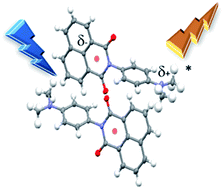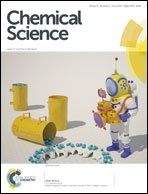Polymorph crystal packing effects on charge transfer emission in the solid state†
Abstract
Condensation of 1,8-naphthalic anhydride with N,N-(dimethylamino)aniline produced the donor–acceptor compound DMIM, which crystallised from a chloroform–diethyl ether mixture to afford two different coloured crystal polymorphs. Crystals for one polymorph are small and green, whereas the other crystals are orange and needle-like. X-ray crystal structures for both polymorphs were determined. The donor N,N-dimethylaniline and acceptor naphthalimide groups are twisted with respect to each other; the degree of twist is marginally different for the two structures. The orange crystal polymorph crystallises in the monoclinic space group C2/c and contains two slightly different molecular conformers in the unit cell (calculated density is 1.410 g cm−3). The green crystal polymorph crystallises in the triclinic space group P![[1 with combining macron]](https://www.rsc.org/images/entities/char_0031_0304.gif) and contains only one type of molecule in the unit cell (calculated density is 1.401 g cm−3). The crystal packing motifs for the two polymorphs are subtly different, explaining the small variance in the observed densities. Very weak room temperature emission was observed for DMIM in a CHCl3 solution, but crystals deposited on a glass slide glowed when irradiated at 488 nm using a fluorescence microscope. Disparate solid-state emission spectra and lifetimes for the two polymorphic crystal forms are observed for the dyad. The emission is assigned to charge recombination fluorescence from a charge transfer state.
and contains only one type of molecule in the unit cell (calculated density is 1.401 g cm−3). The crystal packing motifs for the two polymorphs are subtly different, explaining the small variance in the observed densities. Very weak room temperature emission was observed for DMIM in a CHCl3 solution, but crystals deposited on a glass slide glowed when irradiated at 488 nm using a fluorescence microscope. Disparate solid-state emission spectra and lifetimes for the two polymorphic crystal forms are observed for the dyad. The emission is assigned to charge recombination fluorescence from a charge transfer state.


 Please wait while we load your content...
Please wait while we load your content...